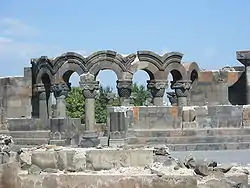Аршакуні (царі Вірменії)
Аршакуні — вірменська (180 — 428) царська династія Великої Вірменії [1] [2] [3][4].

Прапор роду Аршакідів
Заснована Трдатом I, який правив з 54-88 (офіційно з 66)[5], і був братом парфянського царя Вологеза I. До династії Аршакідів належав Трдат III, під час його правління (бл. 301 року н. е.) християнство стало офіційною релігією Вірменії.
Царі Аршакіди намагалися об'єднати країну та добитися її самостійності. Після розділу 387 року Великої Вірменії між Персією та Римом, стали їх васалами. 428 року династія Аршакідів втратила владу.
Примітки
- Encyclopaedia Iranica. Arsakids. The Arsacid Dynasty of Armenia.:«Third dynasty of Armenia (in Armenian, Aršakuni), from the first to the mid-fifth century. The preceding dynasty of the Artaxiads became extinct about A.D. 12, amid a secessionist chaos caused by the perennial struggle of Iran and Rome over Armenia — the second throne, after Media, in the Iranian scheme of vassal kingdoms. It was then that the ex great king of Iran, Vonones I became king of Armenia. After him, seven Arsacid princes from Parthia came at different times to occupy the Armenian throne, interchangeably with six others, candidates of Rome. A compromise was finally attempted in 63 (Treaty of Rhandeia). An Arsacid, Tiridates I, was recognized by both empires as king of Armenia. Roman „friendship“ was imposed upon him — and in 66 he journeyed to Rome to be crowned by Nero — and, at the same time, as a Parthian prince, he was bound to accept the family ascendancy of the head of the Arsacids, the great king. The balance thus established between political and dynastic allegiance proved, however, precarious. Dynastic allegiance often became political as well, and Armenia continued to oscillate between the two rivals. None of the first eight Arsacids who reigned in Armenia founded a line of kings; it was left to the ninth, Vologases (Vałarš) II (180—191), to achieve this: his posterity of thirteen kings formed the Armenian Arsacid dynasty.»
- Encyclopedia Britannica. Arsacid dynasty.: «Arsacid dynasty — also called Arshakuni (247 bc-ad 224), ancient Iranian dynasty that founded and ruled the Parthian empire.»
- Encyclopedia Britannica. Armenia. The Arsacids.:«The Arsacids Both Rome and Parthia strove to establish their own candidates on the Armenian throne until a lasting measure of equilibrium was secured by the treaty of Rhandeia, concluded in ad 63 between the Roman general Gnaeus Domitius Corbulo and Tiridates (Trdat), brother of the Parthian king Vologeses I. Under this treaty a son of the Parthian Arsacid dynasty, the first being Tiridates, would occupy the throne of Armenia but as a Roman vassal.»
- Советская историческая энциклопедия. АРШАКИДЫ. Исп. лит.: Халатьянц Г., Арм. Аршакиды в «Истории Армении» Моисея Хоренского, ч. 1 — М.,1903; Очерки истории СССР, III—IX вв. — М., 1958: « (Аршакуни) армянские — царская династия, родственная Аршакидам парфянским. Основана Тиридатом I (с 62, официально с 66 по 80). Парфия присылала претендента на престол при обязат. санкции рим. императора. После падения парфянских А. и прихода к власти в Иране Сасанидов (226) Хосров I Великий А. (217—238) не признал их воцарения; власть А. стала наследственной. В правление А. в Армении складывались феод. отношения. При Тиридате III Великом (287—332) христианство стало в 301 гос. религией в Армении. А. боролись против феод. раздробленности, а также за независимость Армении, но безуспешно. После раздела Великой Армении в 387 между Ираном и Римом А. стали их вассалами; Армения утратила независимость. В 428 власть А. пала.»
- Гуго Винклер, Карл Нибур, Генрих Шурц. История человечества. Всемирная история. Западная Азия и Арика. Царство парфян при Аршакидах. Перевод В. Бартольда — С-Пб.:1903 — с. 259.: «И при преемниках Артабана продолжались междоусобные войны; неурядицы в Армении и на Востоке потрясали государство. В 58-60 годах еще раз дошло до борьбы между римлянами и парфянами, пока наконец не удалось мирно разрешить армянский вопрос: парфянский князь Тиридат отправился в Рим (62 год) и здесь император Нерон торжественно пожаловал его Арменией.»
This article is issued from Wikipedia. The text is licensed under Creative Commons - Attribution - Sharealike. Additional terms may apply for the media files.
